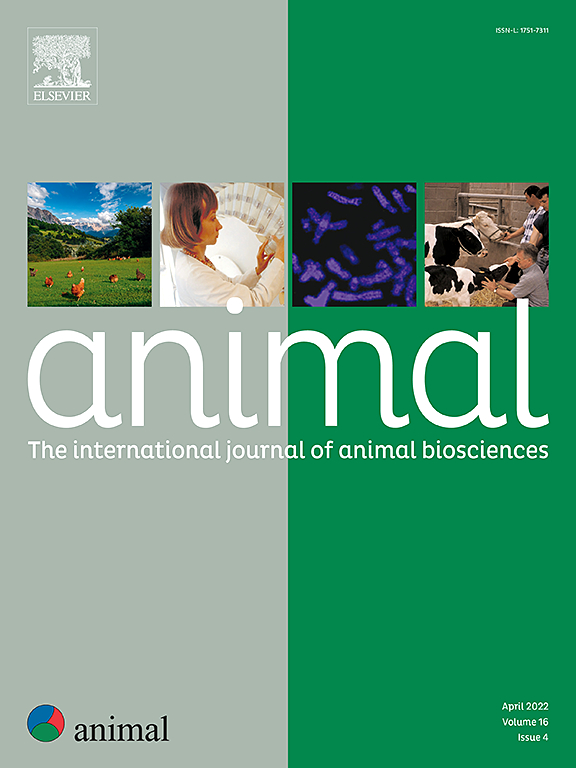Comparison of the effects of production and processing parameters on the eating quality of lamb
IF 4
2区 农林科学
Q1 AGRICULTURE, DAIRY & ANIMAL SCIENCE
引用次数: 0
Abstract
While many separate research studies have investigated the effect of production and processing factors on eating quality of lamb, the relative impact of these parameters has been difficult to ascertain. In this study, the effect of eighteen production and processing factors on the eating quality of Welsh Lamb was compared, using meat from 624 lambs and assessments by 1920 UK consumers. Four experimental trials provided a balanced assessment of production and processing factors: muscle, breed type, lamb gender, ageing, finishing diet, season, carcase hanging and packaging method. The effect of other parameters was assessed using the combined data: farm type, individual farm, liveweight gain, abattoir, slaughter date, carcase weight, carcase conformation, carcase fat grade, age at slaughter, and transport time. The Meat Standards Australia protocol for consumer panels was used to provide a consistent methodology for comparing the effect on palatability of different treatments and factors and the interactions between them. The three factors that had the most significant effect on consumer sensory quality were muscle, season and individual farm. While the differences between muscles are well known, the effects of season within the 1st year and individual farm have not been widely reported. Meat from mid-season lambs received the highest scores for sensory quality while differences in sensory quality between meat from different farms were pronounced and unexplained; further research is needed to evaluate the role of genetics and/or microflora. Younger age and higher intramuscular fat content also gave improved eating quality, with gender and conformation grade having a small effect. Of the postslaughter factors, ageing to 14 or 21 days, gave significantly better eating quality than 7 days ageing, as did hanging “cross-legged” and vacuum packing, compared with Achilles hanging and modified atmosphere packaging, respectively. There was a significant muscle × hanging method interaction, with the greatest effect of “cross-legged” hanging observed in the loin. There was no significant effect of lamb finishing diet, abattoir, preslaughter daily liveweight gain or transportation time on any of the consumer sensory scores. The main factors tested that provide practical scope for improving the eating quality of lamb were ageing of the meat, carcase hanging and meat packaging. If the reasons for inter- and intra-farm differences in lamb quality can be elucidated, this may provide further management tools for improving the quality and consistency of lamb quality.
生产工艺参数对羊肉食用品质影响的比较。
虽然许多独立的研究调查了生产和加工因素对羊肉食用质量的影响,但这些参数的相对影响很难确定。在这项研究中,比较了18个生产和加工因素对威尔士羔羊食用质量的影响,使用了624只羔羊的肉和1920名英国消费者的评估。四项试验提供了对生产和加工因素的平衡评估:肌肉、品种类型、羔羊性别、年龄、肥育日粮、季节、胴体悬挂和包装方法。采用综合数据评估其他参数的影响:养殖场类型、个体养殖场、活重增重、屠宰场、屠宰日期、胴体重、胴体构象、胴体脂肪等级、屠宰年龄和运输时间。澳大利亚肉类标准消费者小组协议被用来提供一个一致的方法来比较不同处理和因素对适口性的影响以及它们之间的相互作用。对消费者感官品质影响最显著的三个因素是肌肉、季节和个体农场。虽然肌肉之间的差异是众所周知的,但第一年和个别农场的季节影响尚未得到广泛报道。来自季节中期羔羊的肉在感官质量上得分最高,而来自不同农场的肉在感官质量上的差异是明显且无法解释的;需要进一步的研究来评估遗传和/或微生物群落的作用。年龄越小、肌内脂肪含量越高也能改善饮食质量,性别和形态等级的影响较小。在屠宰后的因素中,陈化14天或21天的食用质量明显好于陈化7天的食用质量,“盘腿”悬挂和真空包装的效果分别好于阿基里斯悬挂和改良空气包装。肌肉与吊挂方式存在显著的交互作用,其中“盘腿”吊挂在腰部效果最大。羔羊肥育日粮、屠宰场、笑前日活重增加或运输时间对消费者感官评分均无显著影响。试验结果表明,肉质老化、胴体悬挂和肉质包装是提高羊肉食用品质的主要因素。如果能够阐明农场间和农场内羊肉质量差异的原因,这可能为提高羊肉质量和一致性提供进一步的管理工具。
本文章由计算机程序翻译,如有差异,请以英文原文为准。
求助全文
约1分钟内获得全文
求助全文
来源期刊

Animal
农林科学-奶制品与动物科学
CiteScore
7.50
自引率
2.80%
发文量
246
审稿时长
3 months
期刊介绍:
Editorial board
animal attracts the best research in animal biology and animal systems from across the spectrum of the agricultural, biomedical, and environmental sciences. It is the central element in an exciting collaboration between the British Society of Animal Science (BSAS), Institut National de la Recherche Agronomique (INRA) and the European Federation of Animal Science (EAAP) and represents a merging of three scientific journals: Animal Science; Animal Research; Reproduction, Nutrition, Development. animal publishes original cutting-edge research, ''hot'' topics and horizon-scanning reviews on animal-related aspects of the life sciences at the molecular, cellular, organ, whole animal and production system levels. The main subject areas include: breeding and genetics; nutrition; physiology and functional biology of systems; behaviour, health and welfare; farming systems, environmental impact and climate change; product quality, human health and well-being. Animal models and papers dealing with the integration of research between these topics and their impact on the environment and people are particularly welcome.
 求助内容:
求助内容: 应助结果提醒方式:
应助结果提醒方式:


